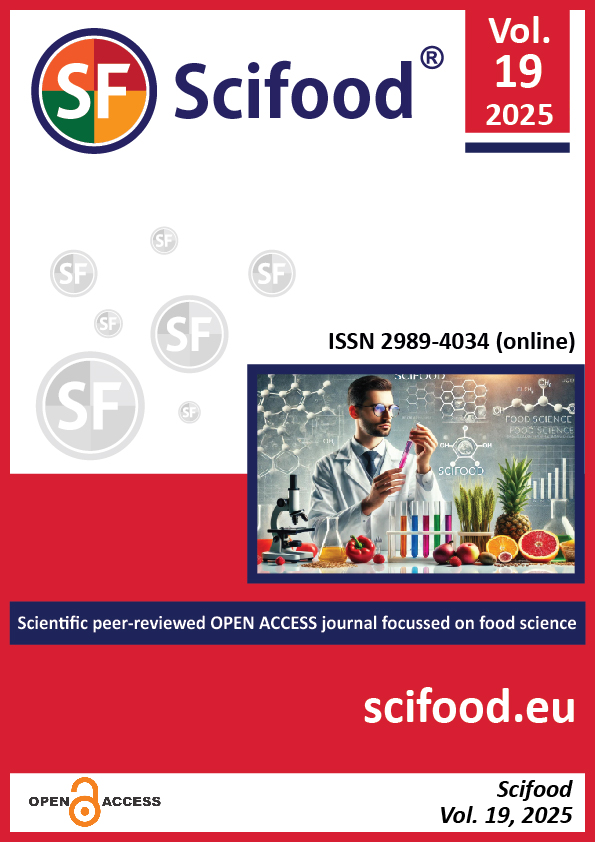The current state of carbon footprint quantification and tracking in the agri-food industry
DOI:
https://doi.org/10.5219/scifood.28Keywords:
carbon footprint, food industry, GHG Protocol, ISO 14064, sustainable food production, decarbonizationAbstract
The agri-food sector is a major contributor to greenhouse gas (GHG) emissions, accounting for approximately 30% of global energy consumption and a substantial share of CO₂, CH₄, and N₂O emissions. As global food systems transition toward sustainability, carbon footprint quantification has become critical for reducing environmental impacts and achieving carbon neutrality goals aligned with the European Green Deal. This paper provides a comprehensive review of methodologies for carbon footprint assessment, including the GHG Protocol – Product Standard, ISO 14064, ISO 14067, Life Cycle Assessment (LCA), and PAS 2050, and their applications in food production systems. A case study on the wheat-to-bread supply chain illustrates the practical application of these frameworks in carbon footprint calculation. The study explores key challenges in carbon footprint tracking, such as data availability and quality issues, complexity of global supply chains, standardization gaps, and financial constraints for small and medium-sized enterprises (SMEs). It further highlights emerging digital technologies, including artificial intelligence (AI), blockchain, and IoT sensors, which enhance emission monitoring, optimize agricultural inputs, and improve transparency in food supply chains. Additionally, the study examines the role of policy frameworks, particularly EU regulations, and the impact of consumer behavior on sustainable food choices. Findings indicate that livestock and fisheries remain the highest-emitting subsectors, while plant-based foods have significantly lower carbon footprints. Integrating digital solutions, standardized methodologies, and regulatory incentives is crucial for improving carbon accounting accuracy and accelerating decarbonization efforts. The paper concludes with recommendations for policymakers, industry stakeholders, and researchers, emphasizing harmonized reporting frameworks, improved access to open carbon databases, and investment in climate-smart agriculture. Strengthening consumer engagement and implementing eco-labeling strategies can further drive demand for low-carbon food products, supporting the transition toward a sustainable and climate-resilient food system.
References
1. Poore, J., & Nemecek, T. (2018). Reducing food’s environmental impacts through producers and consumers. In Science (Vol. 360, Issue 6392, pp. 987-992). American Association for the Advancement of Science. https://doi.org/10.1126/science.aaq0216
2. Garnett, T. (2011). Where are the best opportunities for reducing greenhouse gas emissions in the food system (including the food chain)? In Food Policy (Vol. 36, pp. S23-S32). Elsevier. https://doi.org/10.1016/j.foodpol.2010.10.010
3. Bhatia, P., Cummis, C., Brown, A., Draucker, L., Rich, D., & Lahd, H. (2013). Product Life Cycle Accounting and Reporting Standard. In GHG Protocol Initiative. World Resources Institute, World Business Council for Sustainable Development. Available at: https://ghgprotocol.org/sites/default/files/ghgp/standards/Product-Life-Cycle-Accounting-Reporting-Standard_041613.pdf
4. ISO. (2018a). ISO 14064-1:2018: Greenhouse gases — Part 1: Specification with guidance at the organization level for quantification and reporting of greenhouse gas emissions and removals. In International Organization for Standardization. Available at: https://www.iso.org/standard/66453.html
5. ISO. (2018b). ISO 14067:2018 Greenhouse gases — Carbon footprint of products — Requirements and guidelines for quantification. In International Organization for Standardization. Available at: https://www.iso.org/standard/71206.html
6. Plevin, R. J., Delucchi, M. A., & Creutzig, F. (2014). Using attributional life cycle assessment to estimate climate-change mitigation benefits misleads policy makers. In Journal of Industrial Ecology (Vol. 18, Issue 1, pp. 73-83). Wiley. https://doi.org/10.1111/jiec.12074
7. Matthews, H. S., Hendrickson, C. T., & Weber, C. L. (2008). The importance of carbon footprint estimation boundaries. In Environmental Science & Technology (Vol. 42, Issue 16, pp. 5839-5842). American Chemical Society. https://doi.org/10.1021/es703112w
8. Searchinger, T., Waite, R., Hanson, C., & Ranganathan, J. (2019). Creating a Sustainable Food Future: A Menu of Solutions to Feed Nearly 10 Billion People by 2050. In World Resources Institute. Available at: https://research.wri.org/sites/default/files/2019-07/WRR_Food_Full_Report_0.pdf
9. WRI & WBCSD. (2011). Greenhouse Gas Protocol: Corporate Value Chain (Scope 3) Accounting and Reporting Standard. In World Resources Institute and World Business Council for Sustainable Development. Available at: https://files.wri.org/d8/s3fs-public/pdf/ghgp_launch_factsheet_2011.pdf
10. Abbas, M., Yang, L., & Lahr, M. L. (2024). Globalization’s effects on South Asia’s carbon emissions, 1996–2019: a multidimensional panel data perspective via FGLS. In Humanities and Social Sciences Communications (Vol. 11, Issue 1). Springer Science and Business Media LLC. https://doi.org/10.1057/s41599-024-03704-z
11. Li, S., Siu, Y. W., & Zhao, G. (2021). Driving Factors of CO2 Emissions: Further Study Based on Machine Learning. In Frontiers in Environmental Science (Vol. 9). Frontiers Media SA. https://doi.org/10.3389/fenvs.2021.721517
12. Matear, R. J., & Lenton, A. (2018). Carbon–climate feedbacks accelerate ocean acidification. In Biogeosciences (Vol. 15, Issue 6, pp. 1721–1732). Copernicus GmbH. https://doi.org/10.5194/bg-15-1721-2018
13. Afifa, Arshad, K., Hussain, N., Ashraf, M. H., & Saleem, M. Z. (2024). Air pollution and climate change as grand challenges to sustainability. In Science of The Total Environment (Vol. 928, p. 172370). Elsevier BV. https://doi.org/10.1016/j.scitotenv.2024.172370
14. Pautasso, M., Döring, T. F., Garbelotto, M., Pellis, L., & Jeger, M. J. (2012). Impacts of climate change on plant diseases—opinions and trends. In European Journal of Plant Pathology (Vol. 133, Issue 1, pp. 295–313). Springer Science and Business Media LLC. https://doi.org/10.1007/s10658-012-9936-1
15. Vermeulen, S. J., Campbell, B. M., & Ingram, J. S. I. (2012). Climate Change and Food Systems. In Annual Review of Environment and Resources (Vol. 37, Issue 1, pp. 195–222). Annual Reviews. https://doi.org/10.1146/annurev-environ-020411-130608
16. Alotaibi, M. (2023). Climate change, its impact on crop production, challenges, and possible solutions. In Notulae Botanicae Horti Agrobotanici Cluj-Napoca (Vol. 51, Issue 1, p. 13020). University of Agricultural Sciences and Veterinary Medicine Cluj-Napoca. https://doi.org/10.15835/nbha51113020
17. World Bank. (2019). The Hidden Costs of Food Systems: Environmental and Health Externalities. In World Bank Group. Available at: https://documents1.worldbank.org/curated/en/099612511172347102/pdf/IDU1cfba5ce718dcf1497418d7b1b52e5cc30417.pdf
18. FAO. (2019). The State of Food and Agriculture: Moving Forward on Food Loss and Waste Reduction. In Food and Agriculture Organization of the United Nations. Available at: https://openknowledge.fao.org/server/api/core/bitstreams/11f9288f-dc78-4171-8d02-92235b8d7dc7/content
19. Den Store Klimadatabase. (2024). Food's climate impact database. Danish Think Tank CONCITO. Available at: https://denstoreklimadatabase.dk/en
20. BSI. (2011). PAS 2050:2011: Specification for the assessment of the life cycle greenhouse gas emissions of goods and services. In British Standards Institution. Available at: https://knowledge.bsigroup.com/products/specification-for-the-assessment-of-the-life-cycle-greenhouse-gas-emissions-of-goods-and-services?version=standard
21. Cool Farm Institute. (2013). Cool Farm Tool Online Guide: Crops. Cool Farm Institute. Available at: https://app.coolfarmtool.org/static/doc/CFT_Online_Manual_-_beta.pdf
22. Colomb, V., Aït-Amar, S., Basset-Mens, C., Dollé, J. B., Gac, A., Gaillard, G., Koch, P., Lellahi, A., Mousset, J., Salou, T., Tailleur, A., & van der Werf, H. (2014). AGRIBALYSE: Assessment and lessons for the future. ADEME, Angers, France. Available at: https://nexus.openlca.org/ws/files/8453
23. Koch, P., & Salou, T. (2014). AGRIBALYSE: Methodology, Version 1.1. ADEME, Angers, France. Available at: https://doc.agribalyse.fr/documentation-en/data-use/documentation
24. Carbon Trust. (2024). A Guide to Carbon Footprinting for Businesses. Available at: https://www.carbontrust.com/resources/a-guide-to-carbon-footprinting-for-businesses
25. Intergovernmental Panel on Climate Change (IPCC). (2006). 2006 IPCC Guidelines for National Greenhouse Gas Inventories: Volume 4 – Agriculture, Forestry and Other Land Use. Institute for Global Environmental Strategies (IGES). Available at: https://www.ipcc-nggip.iges.or.jp/public/2006gl/vol4.html
26. Turner, D. A., Williams, I. D., & Kemp, S. (2015). Greenhouse gas emission factors for recycling of source-segregated waste materials. In Resources, Conservation and Recycling (Vol. 105, pp. 186-197). Elsevier. https://doi.org/10.1016/j.resconrec.2015.10.026
27. Weidema, B. P., Thrane, M., Christensen, P., Schmidt, J., & Løkke, S. (2008). Carbon footprint: A catalyst for life cycle assessment? In Journal of Industrial Ecology (Vol. 12, Issue 1, pp. 3-6). Wiley. https://doi.org/10.1111/j.1530-9290.2008.00005.x
28. Finkbeiner, M. (2009). Carbon footprinting—opportunities and threats. In The International Journal of Life Cycle Assessment (Vol. 14, Issue 2, pp. 91-94). Springer. https://doi.org/10.1007/s11367-009-0064-x
29. Wolfert, S., Ge, L., Verdouw, C., & Bogaardt, M. J. (2017). Big Data in Smart Farming – A review. In Agricultural Systems (Vol. 153, pp. 69-80). Elsevier. https://doi.org/10.1016/j.agsy.2017.01.023
30. Eccles, R. G., & Stroehle, J. C. (2018). Exploring Social Origins in the Construction of ESG Measures. In SSRN Electronic Journal. Elsevier. https://doi.org/10.2139/ssrn.3212685
31. Regulation (EU) 2024/1781 of the European Parliament and of the Council of 13 June 2024 establishing a framework for setting ecodesign requirements for sustainable products, amending Directive (EU) 2020/1828 and Regulation (EU) 2023/1542, and repealing Directive 2009/125/EC. Official Journal of the European Union, L 1781, 2024.
32. Johnson, M. P., & Schaltegger, S. (2016). Two Decades of Sustainability Management Tools for SMEs: How Far Have We Come? In Journal of Small Business Management (Vol. 54, Issue 2, pp. 481-505). Wiley. https://doi.org/10.1111/jsbm.12154
33. Grunert, K. G., Hieke, S., & Wills, J. (2014). Sustainability labels on food products: Consumer motivation, understanding, and use. In Food Policy (Vol. 44, pp. 177-189). Elsevier. https://doi.org/10.1016/j.foodpol.2013.12.001
34. Liu, T.-C., Wu, Y.-C., & Chau, C.-F. (2023). An Overview of Carbon Emission Mitigation in the Food Industry: Efforts, Challenges, and Opportunities. In Processes (Vol. 11, Issue 7, p. 1993). MDPI AG. https://doi.org/10.3390/pr11071993
35. Climate TRACE. (2023). Climate TRACE Unveils Open Emissions Database of More Than... In Climate TRACE. Available at: https://climatetrace.org/news/climate-trace-unveils-open-emissions-database-of-more-than
36. World Economic Forum. (2022). 4 ways the food and consumer goods industries can decarbonize... In World Economic Forum. Available at: https://www.weforum.org/stories/2022/11/food-consumer-goods-supply-chains-decarbonization/
37. EDGAR. (2023). The Emissions Database for Global Atmospheric Research. In European Commission, Joint Research Centre (JRC). Available at: https://edgar.jrc.ec.europa.eu/
38. Saberi, S., Kouhizadeh, M., Sarkis, J., & Shen, L. (2018). Blockchain technology and its relationships to sustainable supply chain management. In International Journal of Production Research (Vol. 57, Issue 7, pp. 2117–2135). Informa UK Limited. https://doi.org/10.1080/00207543.2018.1533261
39. Kamilaris, A., Fonts, A., & Prenafeta-Boldύ, F. X. (2019). The rise of blockchain technology in agriculture and food supply chains. In Trends in Food Science & Technology (Vol. 91, pp. 640–652). Elsevier BV. https://doi.org/10.1016/j.tifs.2019.07.034
40. Mana, A. A., Allouhi, A., Hamrani, A., Rehman, S., el Jamaoui, I., & Jayachandran, K. (2024). Sustainable AI-based production agriculture: Exploring AI applications and implications in agricultural practices. In Smart Agricultural Technology (Vol. 7, p. 100416). Elsevier BV. https://doi.org/10.1016/j.atech.2024.100416
41. Khan, R., Dhingra, N., & Bhati, N. (2022). Role of Artificial Intelligence in Agriculture: A Comparative Study. In Transforming Management with AI, Big-Data, and IoT (pp. 73–83). Springer International Publishing. https://doi.org/10.1007/978-3-030-86749-2_4
42. Marvin, H. J. P., Kleter, G. A., Frewer, L. J., Cope, S., Wentholt, M. T. A., & Rowe, G. (2009). A working procedure for identifying emerging food safety issues at an early stage: Implications for European and international risk management practices. In Food Control (Vol. 20, Issue 4, pp. 345–356). Elsevier BV. https://doi.org/10.1016/j.foodcont.2008.07.024
43. Balafoutis, A., Beck, B., Fountas, S., Vangeyte, J., Wal, T., Soto, I., Gómez-Barbero, M., Barnes, A., & Eory, V. (2017). Precision Agriculture Technologies Positively Contributing to GHG Emissions Mitigation, Farm Productivity and Economics. In Sustainability (Vol. 9, Issue 8, p. 1339). MDPI AG. https://doi.org/10.3390/su9081339
44. Klerkx, L., & Rose, D. (2020). Dealing with the game-changing technologies of Agriculture 4.0: How do we manage diversity and responsibility in food system transition pathways? In Global Food Security (Vol. 24, p. 100347). Elsevier BV. https://doi.org/10.1016/j.gfs.2019.100347
45. Schau, E. M., Traverso, M., Lehmann, A., & Finkbeiner, M. (2011). Life Cycle Costing in Sustainability Assessment—A Case Study of Remanufactured Alternators. In Sustainability (Vol. 3, Issue 11, pp. 2268–2288). MDPI AG. https://doi.org/10.3390/su3112268
46. Reisch, L., Eberle, U., & Lorek, S. (2013). Sustainable food consumption: an overview of contemporary issues and policies. In Sustainability: Science, Practice and Policy (Vol. 9, Issue 2, pp. 7–25). Informa UK Limited. https://doi.org/10.1080/15487733.2013.11908111
47. Thøgersen, J. (2014). Unsustainable Consumption. In European Psychologist (Vol. 19, Issue 2, pp. 84–95). Hogrefe Publishing Group. https://doi.org/10.1027/1016-9040/a000176
48. Kamilaris, A., Fonts, A., & Prenafeta-Boldύ, F. X. (2019). The rise of blockchain technology in agriculture and food supply chains. In Trends in Food Science & Technology (Vol. 91, pp. 640–652). Elsevier BV. https://doi.org/10.1016/j.tifs.2019.07.034
49. Marvin, H. J. P., Kleter, G. A., Frewer, L. J., Cope, S., Wentholt, M. T. A., & Rowe, G. (2009). A working procedure for identifying emerging food safety issues at an early stage: Implications for European and international risk management practices. In Food Control (Vol. 20, Issue 4, pp. 345–356). Elsevier BV. https://doi.org/10.1016/j.foodcont.2008.07.024
50. Arvesen, A., Bright, R. M., & Hertwich, E. G. (2011). Considering only first-order effects? How simplifications lead to unrealistic technology optimism in climate change mitigation. In Energy Policy (Vol. 39, Issue 11, pp. 7448–7454). Elsevier BV. https://doi.org/10.1016/j.enpol.2011.09.013
Downloads
Published
Issue
Section
License
Copyright (c) 2025 Jozef Čapla, Peter Zajác, Jozef Čurlej (Author)

This work is licensed under a Creative Commons Attribution-NonCommercial-NoDerivatives 4.0 International License.
This license permits non-commercial re-use, distribution, and reproduction in any medium, provided the original work is properly cited, and is not altered, transformed, or built upon in any way.














